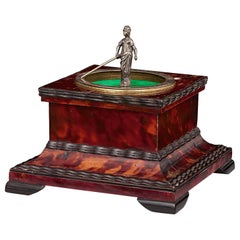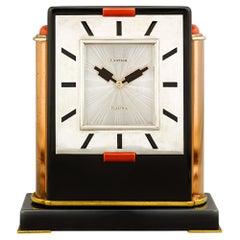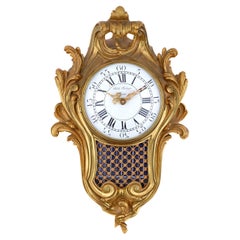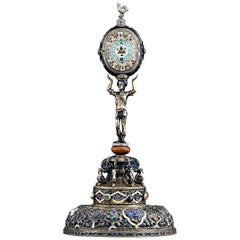Want more images or videos?
Request additional images or videos from the seller
1 of 7
Renaissance Horizontal Table Clock
$27,650List Price
About the Item
- Creator:Andreas Glenck 1 (Clockmaker)
- Dimensions:Height: 3.13 in (7.96 cm)Width: 3.75 in (9.53 cm)Depth: 3.75 in (9.53 cm)
- Style:Other (In the Style Of)
- Materials and Techniques:
- Place of Origin:
- Period:
- Date of Manufacture:circa 1700
- Condition:
- Seller Location:New Orleans, LA
- Reference Number:Seller: 30-16551stDibs: LU89115065603
About the Seller
5.0
Recognized Seller
These prestigious sellers are industry leaders and represent the highest echelon for item quality and design.
Established in 1912
1stDibs seller since 2010
114 sales on 1stDibs
Typical response time: 8 hours
Authenticity Guarantee
In the unlikely event there’s an issue with an item’s authenticity, contact us within 1 year for a full refund. DetailsMoney-Back Guarantee
If your item is not as described, is damaged in transit, or does not arrive, contact us within 7 days for a full refund. Details24-Hour Cancellation
You have a 24-hour grace period in which to reconsider your purchase, with no questions asked.Vetted Professional Sellers
Our world-class sellers must adhere to strict standards for service and quality, maintaining the integrity of our listings.Price-Match Guarantee
If you find that a seller listed the same item for a lower price elsewhere, we’ll match it.Trusted Global Delivery
Our best-in-class carrier network provides specialized shipping options worldwide, including custom delivery.You May Also Like
E. F. Caldwell Renaissance Revival Clock
By Edward F. Caldwell & Co.
Located in New York, NY
Gilded and Patinated Bronze Mounted Renaissance Revival Mantel Clock with blue enamel detail
This highly ornamented clock from the renowned E.F. Caldwell company is an incredible ex...
Category
Early 20th Century American Renaissance Revival Mantel Clocks
Materials
Marble, Bronze, Enamel
Silver table clock 800
By Arval Argenti Valenza
Located in VALENZA, IT
800 silver table alarm clock.
The clock has a rectangular case and a guilloché design with a further parallelepiped as a base left polished which gives it elegance and stability.
The...
Category
Vintage 1980s Italian Other Table Clocks and Desk Clocks
Materials
Velvet
A Monumental Renaissance Revival Clock Garniture, Attributed to Feuchère
Located in Brighton, West Sussex
A Large and Important Louis Philippe Period Gilt-Bronze Three-Piece Clock Garniture.
Attributed to the Feuchère family. The clock movement by Hémon.
In the Renaissance revival style. Comprising a clock and a pair of nine-light candelabra. The clock case of architectural out-shape with cherubic term figures supporting a rectangular pediment centred by an urn. The sides of the clock tower cast in relief with strapwork and foliage. The dial inset with enamel Roman numeral chapters. The twin-barrel clock movement with tic-tac escapement, silk suspension and countwheel strike to bell. Pendulum and winding key.
The candelabra as twin-handled vases supporting tiered branches with candle nozzles. Modelled en suite with naturalistic scrolls and foliage. Surmounted by finials modelled as an eagle toying with a serpent. The scrolled handles flanked by cherubic figures and serpents. The bodies fronted by bacchic masks and supported on socles bearing angels.
France, Circa 1835.
The clock movement signed ‘HEMON A PARIS’. The clockmaker Claude Hémon was established at rue de St. Martin circa 1810-1820.
Dimensions, the clock:
Height : 106 cm 42 inches
Width : 58 cm 23 inches
Depth : 38 cm 15 inches
Weight : 72 kg
Dimensions, the candelabra:
Height : 104 cm 41 inches
Width : 36 cm 14 inches
Depth : 36 cm 14 inches
Weight : 28 kg (each)
This magnificent clock garniture of palatial size is designed in the Renaissance revival style and dates to the Louis Philippe period. Executed in sculptural gilt-bronze with leaves, scrolls, masks and exotic birds, the naturalistic ornament represents an elaborate system of allegories and mythological iconography which recall the influence of Italian Mannerist art in France.
The distinctive design reflects a new style which replaced the neoclassism of the French Empire period. With the fall of Napoleon Bonaparte, artists and designers sought a new decorative vocabulary with which to aggrandise the Bourbon restoration. With the French revolution and Louis XVI’s execution still within living memory, it seemed too soon for a revival of the style of the Grand Siècle. Instead they looked further back to the time of François I, whose patronage of Italian artists had brought the Renaissance to France. The idea of a renaissance revival appealed to the new Bourbon monarchs and their patronage ignited great creativity in the arts.
The reigns of Louis XVIII and Charles X, who were brothers of the late King, Louis XVI, and later of Louis Philippe I, nicknamed the Citizen King, coincided with the enlightenment and the dawn of the industrial age. Great technical progress was made in metallurgy and casting which raised the art of bronze making to new heights in the hands of great masters such as Pierre-Philippe Thomire (1751-1843) and Pierre- Jean-François Denière (1774-1866).
The renaissance provided a rich and varied source book in architecture, furniture and other decorative arts for designers such as Claude Aimé Chenavard (1798-1838) whose Album de l’ornemaniste (1835) became a reference work. Léon Feuchère (1804-1857) also produced drawings of interiors, silver, bronzes and furniture and was a scion of the prominent family of bronze castors established by his grandfather Pierre-François Feuchère (1737-1823) who had worked as a gilder for the bronze caster Pierre Gouthière before setting up a bronze foundry that would become one of the largest in Paris under the management of his son Lucien-François (d. 1841) and grand-son Armand (1797-1866). A number of drawings by Léon Feuchère have recently been discovered by the Rijksmuseum and probably belonged to the collection of Louis-Philippe-Albert, duc d’Orléans, comte de Paris (1838-1894). Louis-Philippe-Albert was the grandson of the French king, Louis-Philippe I (1773-1850), who granted him the title of comte de Paris, and the son of Ferdinand-Philippe, duc d’Orléans (1810-1842). Ferdinand-Philippe was an important collector and sponsored many young artists to create metalwork objets d’art, notably a celebrated surtout de table made by Claude-Aimé Chenavard and Jean-Jacques Feuchère (1807-1852), a cousin of Armand and Léon. Principally remembered as a sculptor, Jean-Jacques Feuchère trained in the family foundry and designed small objects, cigar boxes...
Category
Antique Early 19th Century French Renaissance Revival Mantel Clocks
Materials
Bronze
$247,637
H 41.74 in W 22.84 in D 14.97 in
Renaissance Style Gilt Bronze and Enamel Mantel Clock
Located in London, GB
Renaissance style gilt bronze and enamel mantel clock
French, late 19th century
Measures: Height 53cm, width 28cm, depth 23cm
This exquisite mantel clock is crafted in the idios...
Category
Antique Late 19th Century French Renaissance Revival Mantel Clocks
Materials
Ormolu, Bronze, Enamel
$14,077 Sale Price
30% Off
H 20.87 in W 11.03 in D 9.06 in
Renaissance Revival Enamel and Gilt Bronze Mantel Clock
Located in London, GB
Renaissance Revival enamel and gilt bronze mantel clock
French, late 19th century
Size: Height 53cm, width 29cm, depth 22cm
The mantel clock i...
Category
Antique Late 19th Century French Renaissance Revival Mantel Clocks
Materials
Ormolu, Bronze, Enamel
$14,077 Sale Price
30% Off
H 20.87 in W 11.42 in D 8.67 in
Antique Bronze Angel Table Clock
By Mice di rugiano domenico e c. s.n.c.
Located in Cantù, IT
Antique Bronze Angel Table Clock
Category
Antique Early 1800s Italian Other Table Clocks and Desk Clocks
Materials
Bronze
Large French Renaissance Revival Bronze Mounted Carved Walnut Mantel Clock
Located in Tarzana, CA
A magnificent 19th century French Renaissance Revival patinated bronze mounted carved walnut "Day and Night" mantel clock.
The dial with Roman numerals flanked by allegorical figures of night and day after Michelangelo.
France, circa 1870
Maker: Victor Paillard
The movement stamped: Vr. Paillard, Paris. Rodier Paris Stamp & Medaille Dor', 1837
Dimensions:
Height 22" (56 cm)
Width 37" (94 cm)
Depth 9" (22 cm)
Victor Paillard (1805-1886) designed and made various bronze decorative and functional objects including chenets, lighting and clocks. He also cast bronzes for some of the most important sculptors of the day including Barye, Carrier-Belleuse and Pradier
He opened his first workshop in the 1830s at 105, boulevard Beaumarchais and 6, rue Saint-Claude and by the 1850s was employing around 100 people. His success at numerous international exhibitions including the 1851 Great Exhibition (where he displayed a bronze of the Standing Sappho after Pradier) further enhanced his reputation
Day and night by Michelangelo: Though never finished, the tomb of Giuliano de' Medici in the Medici Chapel is the only one of Michelangelo great architectural-sculptural projects to be realized in a form approaching completion.
Built between 1520 and 1534, it is widely held to be one of Michelangelo's most stunning achievements.
The pose of the central figure on the tomb of Giuliano de' Medici, arms resting at his sides and legs comfortably apart, and its open composition suggest a cheerful Duke, generous in both mind and spirit. In fact, the figure holds in his hand several coins, as if an intended gift. Light plays freely on his beautiful face, yet the figure is lacking in energy and seems to wilt under the burden of the Roman armor...
Category
Antique 19th Century French Renaissance Revival Clocks
Materials
Marble, Bronze
$18,600
H 22 in W 37 in D 9 in
Omega i Table Clock
By Nomon
Located in NEW YORK, NY
The Omega I Clock impresses by keeping a clock suspended in the air while losing its depth by removing unnecessary items and making it simple and glamorous .
Omega i table clock : R...
Category
2010s Spanish Modern Wall Clocks
Materials
Stainless Steel, Chrome
Omega G Table Clock
By Nomon
Located in NEW YORK, NY
The Omega G Clock impresses by keeping a clock suspended in the air while losing its depth by removing unnecessary items and making it simple and glamorous .
Omega G table...
Category
2010s Spanish Modern Wall Clocks
Materials
Stainless Steel, Brass
Douglas Clock Silver Travel Table Clock
Located in Vienna, AT
Sterling silver construction originally gold plated inside. Manufacturer by Douglas Clock Co Ltd
Size: 8.5 x 5.5 x 4.5 cm
Dial: White with black roman numerals
Pointer: Black
...
Category
Antique Early 1900s British Table Clocks and Desk Clocks
Materials
Sterling Silver
More From This Seller
View AllBuschman “Minerva” German Horizontal Table Clock
Located in New Orleans, LA
The extraordinary beauty and superior craftsmanship of 17th century German clockmaking is on full display in this exceptionally rare horizontal tabletop timepiece dating to 1650 Augsburg. Created by Johannes Buschman the Younger, the eminent Buschman family of clockmakers are lauded for designing some of the finest timepieces to ever be created in the South German town of Augsburg during the late Renaissance and early Modern periods. A finely moulded ebony and turtleshell casing veneered in a mottled red hue holds the clock’s fusée and chain movement with verge escapement and balance with hogs-bristle regulation. A silver figure of Minerva, Roman goddess of war and wisdom, centers the Roman numeral-engraved chapter ring, indicating the time by pointing to the hour with an authoritative military staff as the sun rotates below her feet to indicate the minute. The incredible design is finished by a gilded backplate intricately pierced and engraved with a floral motif and the signature of Johannes Buschman.
Clocks are one of the greatest and most important inventions of the Renaissance period, improving steadily into the Age of Discovery. Embodying a renewed interest in science, the arts and humanism, the first mechanical timepieces began appearing in the 14th century and were large, weight-driven devices placed in the turrets of public buildings that struck the hour and lacked hands and faces. This clock was created during the first period of household clocks, when spring-driven movements made it possible to create smaller and more complex mechanisms. Such creations, however, were a luxury accessible only to the wealthy upper classes. Affluent patrons placed pressure upon artisans to create more elaborate and ornate clocks...
Category
Antique 17th Century German Renaissance Table Clocks and Desk Clocks
Materials
Silver
Cartier Art Deco Table Clock
By Cartier
Located in New Orleans, LA
This Art Deco period table clock by Cartier is an extremely rare find and in a class of its own. Crafted of black lacquer, no detail was spared by the famed firm in creating this hig...
Category
20th Century French Art Deco Table Clocks and Desk Clocks
Materials
Silver, Brass
$28,500
Patek Philippe Cartel Clock
By Patek Philippe
Located in New Orleans, LA
The famed Patek Philippe crafted this spectacular gilt bronze cartel clock. The case is exuberantly embellished in the Louis XV style with scrolling foliate work and an argyle-patterned screen punctuated with rosettes. The decorative screen conceals a panel of solar cells on the front of the timepiece. These photoelectric cells, along with a backup lithium battery, power the caliber 17-250 mechanical movement. It tells the time on a white enamel dial with both Roman and Arabic numerals and ornate brass hands. The timepiece comes complete with its original fitted Patek Philippe box. Overall, this clock displays the lasting quality and style of this legendary Swiss firm.
Patek Philippe is one of the world’s premier luxury brands and is widely regarded as the world's most prestigious watchmaker. Founded in 1851 by Polish watchmaker Antoni Patek and French watchmaker Adrien Philippe...
Category
Mid-20th Century Swiss Other Wall Clocks
Materials
Bronze
$74,500
Viennese Enamel Soldier Clock
By Tobias Katzenberger
Located in New Orleans, LA
A work of exceptional detail, this magnificent Viennese clock takes the art form of enameling to new heights. The elaborately fashioned timepiece rests atop the head of a soldier, who stands on a pedestal populated by sphinxes. Exceptional details encase the entire piece, from the rooster finial to the gem-studded base. A hand-painted portrait of the heroic soldier on the reverse completes this stunning piece.
Particularly popular during the 19th century, Viennese enamels...
Category
Antique Early 19th Century Austrian Other Mantel Clocks
Materials
Multi-gemstone, Enamel
Joe DiMaggio's Presentation Desk Clock
Located in New Orleans, LA
From the personal collection of the legendary Joe DiMaggio, this incredible vintage desk clock was presented to the Yankee Clipper by Harrah's for his par...
Category
20th Century Swiss Other Table Clocks and Desk Clocks
Materials
Brass
Art Deco J.E. Caldwell Table Clock
By J.E. Caldwell & Co.
Located in New Orleans, LA
This luxurious and rare table clock is the essence of Art Deco style. Retailed at the renowned J. E. Caldwell & Co., this exceptional timepiece is comprised of a French clock movement...
Category
20th Century American Art Deco Table Clocks and Desk Clocks
Materials
Enamel
Recently Viewed
View AllMore Ways To Browse
Used Casement Windows
Antique Casement Windows
Museum Clock
Horizontal Clock
Horizontal Table Clock
Antique Clocks Birmingham
Art Deco Blue Mirror Clock
J E Caldwell Clock
Pendulum Clocks Glass
Vintage Zodiac Clock
Wooden Table Clock
Art Deco Kienzle Clock
Art Deco Kienzle
French Bakelite Clocks
Memphis Table Clocks
Unique Table Clocks
Vintage Packaging
Alarm Clock 1930



